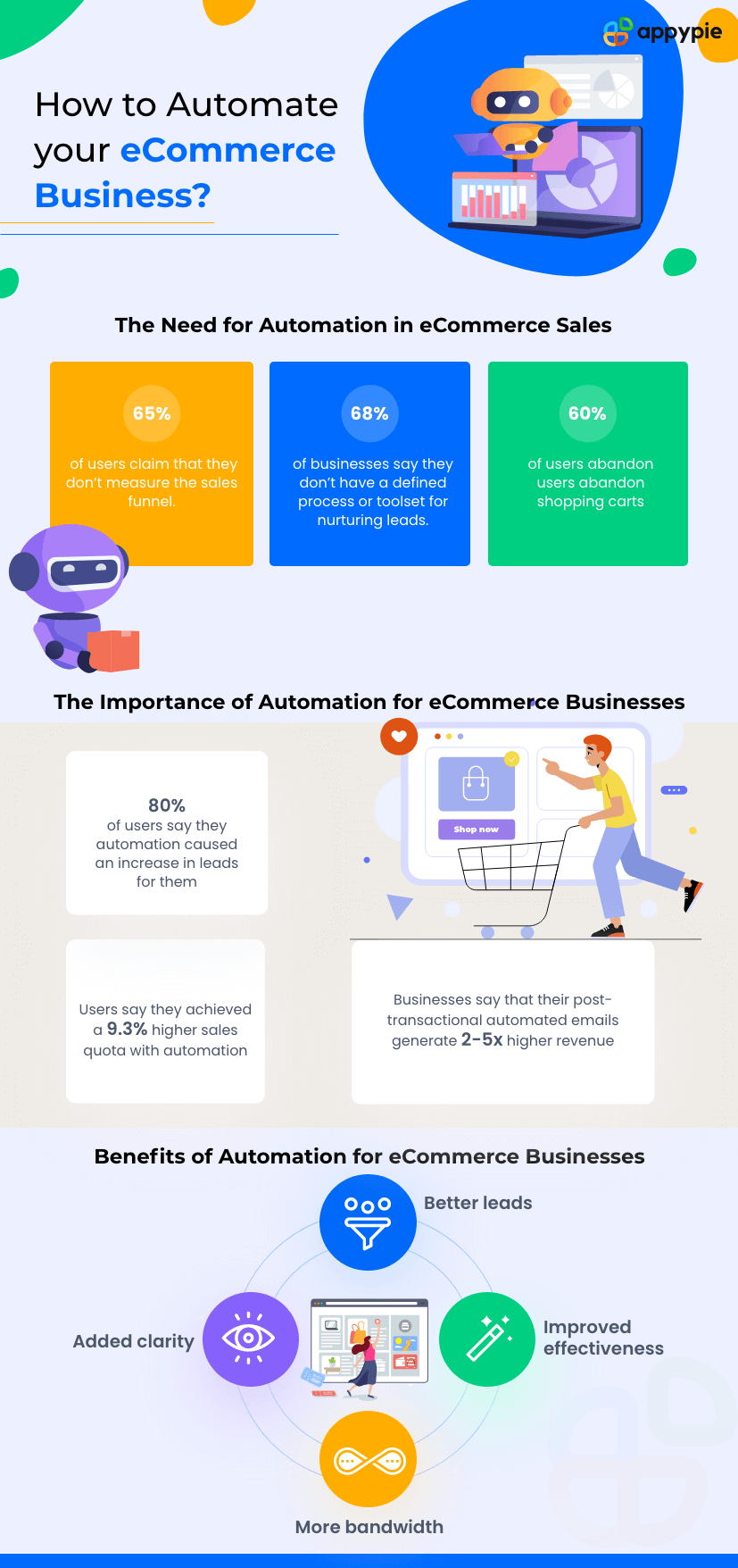Top eCommerce Integrations for Your Online Store

Ecommerce apps are all the rage now among online store owners and internet users alike. However, in recent times, eCommerce businesses have realized that the apps can be a little limiting if you truly want to go out of the box in serving your customers. Hence, eCommerce integrations with other third-party apps have proved to be of great convenience. These integrations can help deploy useful eCommerce automation for greater productivity and efficiency in your business. It can be intimidating for business owners to determine which third-party apps make the most sense for their eCommerce app or website. Appy Pie Connect has a well-categorized app directory that you can explore to figure out which integrations will help you improve your online store
Table of Contents
Introduction
There are multiple aspects of running an eCommerce store. Each aspect involves multiple tasks with specific goals which need third-party software for smooth functioning. These may include software for CRM, analytics, accounting, internal communication, customer support, and more. To make the processes simpler and faster, you must find a way to integrate the support applications with your own eCommerce business. These integrations reduce human involvement, eliminate repetitive tasks, and eventually reduce operational costs for your eCommerce store. Further in the blog, we will discuss the need for eCommerce integrations, how eCommerce integrations work, and the top eCommerce integrations for your online business. Here is an interesting infographic to help you understand the significance of eCommerce automation.
Why do you need eCommerce integrations?
As you can see in the infographic above, eCommerce integrations have gained immense popularity and acceptance among eCommerce business owners. Let us now discuss the reasons why you need eCommerce integrations in detail.- Streamline your workflows Well-planned eCommerce integrations can help streamline your most complex workflows, improving the experience for both the customer and the app admin. You can use eCommerce automation through meaningful integrations to provide a smooth and fast shopping experience to the users so that they do not have to hop from one portal to the other. Wouldn’t you prefer to make the payment within the system instead of receiving a link on your email or text? Similarly, the business owner or admin would prefer an integrated CRM system for simpler, more clean processes.
- Sync data flow between systems For an eCommerce business, it is imperative that the owner has access to a comprehensive, consistent overview of their business objects across systems. For example, a combined view of the customer across different business lines, a comprehensive view of the entire supply chain inventory and demand patterns, a comprehensive view of their financial data across all the financial tracking systems, etc. With specialized integrations for each of these activities, it is possible to synchronize data between multiple systems and create a smooth data flow without compromising security.
- Reduce manual errors and data redundancy As mentioned above, eCommerce automation with third-party application integrations reduces human involvement in mundane, repetitive tasks. Naturally, this reduces the chances of any human errors, thus improving the overall efficiency.
- Gain better control over business operations As you bring multiple processes in one place through meaningful eCommerce integrations, you gain access to a comprehensive view of all operations within your organization. By getting access to all aspects like manufacturing, shipping, finances, CRM, marketing, etc., in one place, you establish stronger control over your business, and you can work more effectively towards improving your business’ bottom line.
How do eCommerce integrations work?
On Appy Pie Connect, the best workflow automation platform, eCommerce integrations work on the principle of triggers and actions. Essentially, the actions that happen on the front end of your eCommerce application trigger corresponding events on other applications. To put it simply, the front end of your site and the back end of the integrated third-party applications are in constant communication. For example, if a customer registers on your eCommerce app, their information is automatically recorded on your CRM database. A simple eCommerce automation like this can save you time and effort, which can be redirected or focused on more pressing tasks.Top 7 eCommerce integrations
For this blog, we are taking the critical integrations based on categories, and then to drive the point home, we are going to establish our point with some meaningful eCommerce integration examples.- Payment gateways integrations You need to integrate at least one payment gateway into your eCommerce store for safe online transactions. This will help you receive payments from your customers without worrying about any data theft or financial hacks. Here are some examples of popular payment gateways eCommerce integrations
- Automate workflows with Shopify Stripe integrations
- Automate workflows with AWS Paypal integrations
- Automate workflows with BigCommerce Expensify integrations
- CRM integrations Customer relationship management or CRM primarily includes collecting customer data, leveraging data to improve customer loyalty and enhance marketing, sales, and customer service. The ultimate goal of CRM systems is to retain customers, which benefits the business more than mindless customer acquisition.
- Explore Salesforce Shopify integrations
- Explore WooCommerce Salesforce integrations
- Explore Hubspot Shopify integrations
- Shipping integrations Once a customer clicks on the purchase button, your job as the eCommerce store owner begins. There are myriad tasks like order processing, pick-up, packaging, and shipping. The entire shipping process is highly labor-intensive and thus open to numerous human errors. Ecommerce shipping integration automates critical workflows and brings down the labor and chances of error. Let’s look at some of the most popular eCommerce shipping integrations.
- Integrate Shippo and Magento 2.X now!
- Integrate Easyship and Etsy now!
- Integrate ShipStation and WooCommerce now!
- Email and marketing automation integrations Ecommerce marketing automation software helps you categorize the customers into groups based on their nature of engagement with the website or business as a whole. Once you have a decent customer database, it makes sense to launch some nurturing campaigns through emails and send product recommendations or announce the latest discounts. Marketing automation software ensure that the grouping is done right and the marketing communication is sent out in a targeted manner.
- Email automation with Shopify MailChimp integrations
- Marketing automation with ActiveCampaign WooCommerce integrations
- Email automation with Klaviyo Shopify integrations
- Analytics integrations The customer behavior data from your analytics software is pure gold. You can learn a lot from your customers’ behavior, like a high bounce rate indicates friction on the page, abandoned carts indicate UI issues with the page, high shipping rates, etc.
- Connect BigCommerce and Bitly now!
- Connect Magento 2.X and Konnect Insights now!
- Connect Etsy and Bitly now!
- Accounting integrations With the right accounting eCommerce integrations, accounting activities like bookkeeping, invoice generation, profit and loss tracking, etc., are simplified. It is a great way to sync all the data related to sales and orders with the rest of your financial information.
- Explore Xero Shopify integrations
- Explore Shopify Quickbooks integrations
- Explore BigCommerce Alegra integrations
- Customer support integrations Modern-day customers expect stellar customer service. Live chat and chatbots can be integrated easily into your eCommerce store using Appy Pie Livechat and Appy Pie Chatbot.
Related Articles
- Demystifying Explainable AI (XAI)
- Guide to Custom Apple Watch Faces & DIY App Development
- What is a Virtual Assistant and What they do?
- Top 13 Performance Improvement Plan Examples
- Machine Learning & Its Application in Our Daily Lives
- How to integrate Chatbot using SDK for Android and iPhone?
- Android to TV Casting Made Easy: A Step-by-Step Guide for Everyone
- Customer Service: Definition, Skills, and More!
- 15 Proven Ways to Increase Repair Sales in Your Automotive Service
- 17 Best Shopify Alternatives to Consider in 2023
